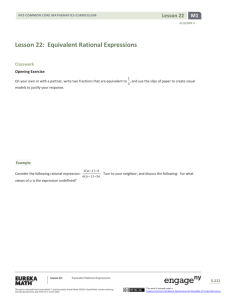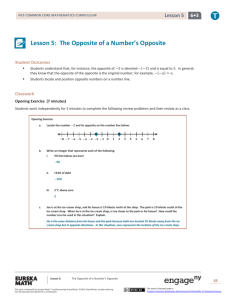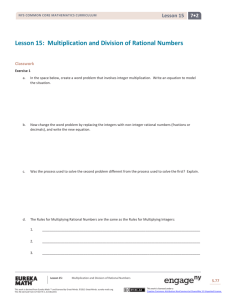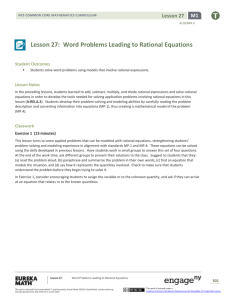Lesson 27: Word Problems Leading to Rational
advertisement
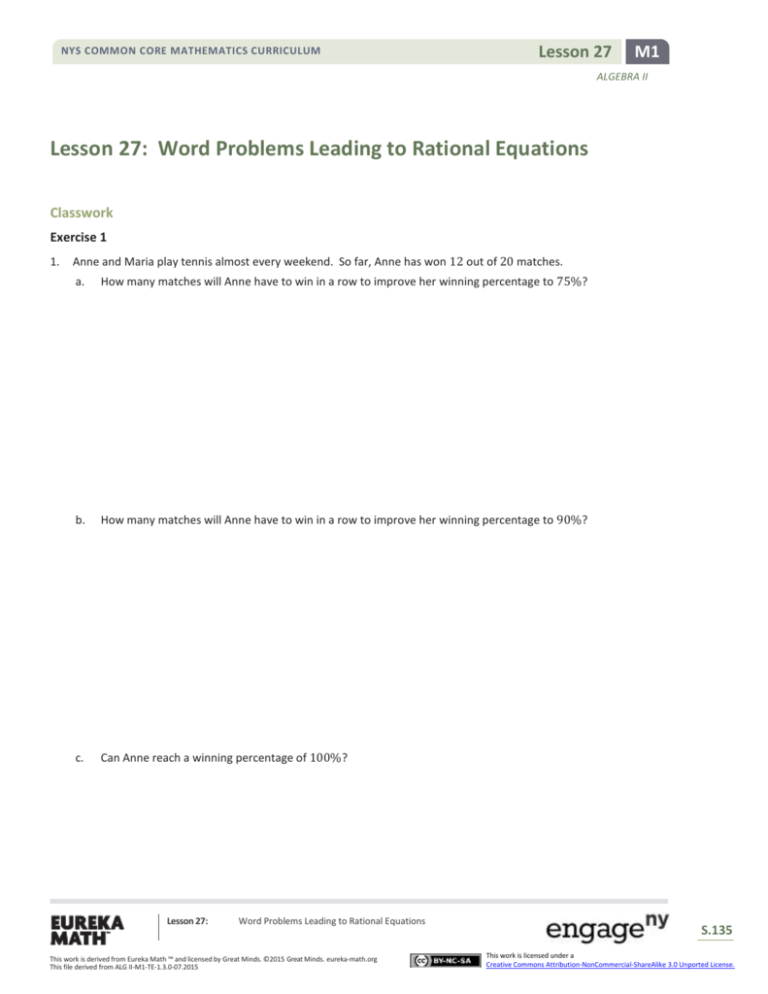
NYS COMMON CORE MATHEMATICS CURRICULUM Lesson 27 M1 ALGEBRA II Lesson 27: Word Problems Leading to Rational Equations Classwork Exercise 1 1. Anne and Maria play tennis almost every weekend. So far, Anne has won 12 out of 20 matches. a. How many matches will Anne have to win in a row to improve her winning percentage to 75%? b. How many matches will Anne have to win in a row to improve her winning percentage to 90%? c. Can Anne reach a winning percentage of 100%? Lesson 27: Word Problems Leading to Rational Equations This work is derived from Eureka Math ™ and licensed by Great Minds. ©2015 Great Minds. eureka-math.org This file derived from ALG II-M1-TE-1.3.0-07.2015 S.135 This work is licensed under a Creative Commons Attribution-NonCommercial-ShareAlike 3.0 Unported License. NYS COMMON CORE MATHEMATICS CURRICULUM Lesson 27 M1 ALGEBRA II d. After Anne has reached a winning percentage of 90% by winning consecutive matches as in part (b), how many matches can she now lose in a row to have a winning percentage of 50%? Example Working together, it takes Sam, Jenna, and Francisco two hours to paint one room. When Sam works alone, he can paint one room in 6 hours. When Jenna works alone, she can paint one room in 4 hours. Determine how long it would take Francisco to paint one room on his own. Exercises 2–4 2. Melissa walks 3 miles to the house of a friend and returns home on a bike. She averages 4 miles per hour faster when cycling than when walking, and the total time for both trips is two hours. Find her walking speed. Lesson 27: Word Problems Leading to Rational Equations This work is derived from Eureka Math ™ and licensed by Great Minds. ©2015 Great Minds. eureka-math.org This file derived from ALG II-M1-TE-1.3.0-07.2015 S.136 This work is licensed under a Creative Commons Attribution-NonCommercial-ShareAlike 3.0 Unported License. NYS COMMON CORE MATHEMATICS CURRICULUM Lesson 27 M1 ALGEBRA II 3. You have 10 liters of a juice blend that is 60% juice. a. How many liters of pure juice need to be added in order to make a blend that is 75% juice? b. How many liters of pure juice need to be added in order to make a blend that is 90% juice? c. Write a rational equation that relates the desired percentage 𝑝 to the amount 𝐴 of pure juice that needs to be added to make a blend that is 𝑝% juice, where 0 < 𝑝 < 100. What is a reasonable restriction on the set of possible values of 𝑝? Explain your answer. d. Suppose that you have added 15 liters of juice to the original 10 liters. What is the percentage of juice in this blend? Lesson 27: Word Problems Leading to Rational Equations This work is derived from Eureka Math ™ and licensed by Great Minds. ©2015 Great Minds. eureka-math.org This file derived from ALG II-M1-TE-1.3.0-07.2015 S.137 This work is licensed under a Creative Commons Attribution-NonCommercial-ShareAlike 3.0 Unported License. NYS COMMON CORE MATHEMATICS CURRICULUM Lesson 27 M1 ALGEBRA II e. 4. Solve your equation in part (c) for the amount 𝐴. Are there any excluded values of the variable 𝑝? Does this make sense in the context of the problem? You have a solution containing 10% acid and a solution containing 30% acid. a. How much of the 30% solution must you add to 1 liter of the 10% solution to create a mixture that is 22% acid? b. Write a rational equation that relates the desired percentage 𝑝 to the amount 𝐴 of 30% acid solution that needs to be added to 1 liter of 10% acid solution to make a blend that is 𝑝% acid, where 0 < 𝑝 < 100. What is a reasonable restriction on the set of possible values of 𝑝? Explain your answer. Lesson 27: Word Problems Leading to Rational Equations This work is derived from Eureka Math ™ and licensed by Great Minds. ©2015 Great Minds. eureka-math.org This file derived from ALG II-M1-TE-1.3.0-07.2015 S.138 This work is licensed under a Creative Commons Attribution-NonCommercial-ShareAlike 3.0 Unported License. NYS COMMON CORE MATHEMATICS CURRICULUM Lesson 27 M1 ALGEBRA II c. Solve your equation in part (b) for 𝐴. Are there any excluded values of 𝑝? Does this make sense in the context of the problem? d. If you have added some 30% acid solution to 1 liter of 10% acid solution to make a 26% acid solution, how much of the stronger acid did you add? Lesson 27: Word Problems Leading to Rational Equations This work is derived from Eureka Math ™ and licensed by Great Minds. ©2015 Great Minds. eureka-math.org This file derived from ALG II-M1-TE-1.3.0-07.2015 S.139 This work is licensed under a Creative Commons Attribution-NonCommercial-ShareAlike 3.0 Unported License. Lesson 27 NYS COMMON CORE MATHEMATICS CURRICULUM M1 ALGEBRA II Problem Set 1. If two inlet pipes can fill a pool in one hour and 30 minutes, and one pipe can fill the pool in two hours and 30 minutes on its own, how long would the other pipe take to fill the pool on its own? 2. If one inlet pipe can fill the pool in 2 hours with the outlet drain closed, and the same inlet pipe can fill the pool in 2.5 hours with the drain open, how long does it take the drain to empty the pool if there is no water entering the pool? 3. It takes 36 minutes less time to travel 120 miles by car at night than by day because the lack of traffic allows the average speed at night to be 10 miles per hour faster than in the daytime. Find the average speed in the daytime. 4. The difference in the average speed of two trains is 16 miles per hour. The slower train takes 2 hours longer to travel 170 miles than the faster train takes to travel 150 miles. Find the speed of the slower train. 5. A school library spends $80 a month on magazines. The average price for magazines bought in January was 70 cents more than the average price in December. Because of the price increase, the school library was forced to subscribe to 7 fewer magazines. How many magazines did the school library subscribe to in December? 6. An investor bought a number of shares of stock for $1,600. After the price dropped by $10 per share, the investor sold all but 4 of her shares for $1,120. How many shares did she originally buy? 7. Newton’s law of universal gravitation, 𝐹 = 𝐺𝑚1𝑚2 , measures the force of gravity between two masses 𝑚1 and 𝑚2 , 𝑟2 where 𝑟 is the distance between the centers of the masses, and 𝐺 is the universal gravitational constant. Solve this equation for 𝐺. 8. 9. Suppose that 𝑡 = 𝑥+𝑦 . 1−𝑥𝑦 1 2𝑎−1 and 𝑦 = , the value of 𝑡 does not depend on the value of 𝑎. 𝑎 𝑎+2 a. Show that when 𝑥 = b. For which values of 𝑎 do these relationships have no meaning? Consider the rational equation 1 𝑅 = 1 𝑥 1 + . 𝑦 2 3 and 𝑦 = . 5 4 a. Find the value of 𝑅 when 𝑥 = b. Solve this equation for 𝑅, and write 𝑅 as a single rational expression in lowest terms. Lesson 27: Word Problems Leading to Rational Equations This work is derived from Eureka Math ™ and licensed by Great Minds. ©2015 Great Minds. eureka-math.org This file derived from ALG II-M1-TE-1.3.0-07.2015 S.140 This work is licensed under a Creative Commons Attribution-NonCommercial-ShareAlike 3.0 Unported License. Lesson 27 NYS COMMON CORE MATHEMATICS CURRICULUM M1 ALGEBRA II 10. Consider an ecosystem of rabbits in a park that starts with 10 rabbits and can sustain up to 60 rabbits. An equation that roughly models this scenario is 60 𝑃= 1+ 5 𝑡+1 , where 𝑃 represents the rabbit population in year 𝑡 of the study. a. What is the rabbit population in year 10? Round your answer to the nearest whole rabbit. b. Solve this equation for 𝑡. Describe what this equation represents in the context of this problem. c. At what time does the population reach 50 rabbits? Extension: 11. Suppose that Huck Finn can paint a fence in 5 hours. If Tom Sawyer helps him pain the fence, they can do it in 3 hours. How long would it take for Tom to paint the fence by himself? 12. Huck Finn can paint a fence in 5 hours. After some practice, Tom Sawyer can now paint the fence in 6 hours. a. How long would it take Huck and Tom to paint the fence together? b. Tom demands a half-hour break while Huck continues to paint, and they finish the job together. How long does it take them to paint the fence? c. Suppose that they have to finish the fence in 3 hours. What’s the longest break that Tom can take? 1 2 Lesson 27: Word Problems Leading to Rational Equations This work is derived from Eureka Math ™ and licensed by Great Minds. ©2015 Great Minds. eureka-math.org This file derived from ALG II-M1-TE-1.3.0-07.2015 S.141 This work is licensed under a Creative Commons Attribution-NonCommercial-ShareAlike 3.0 Unported License.





